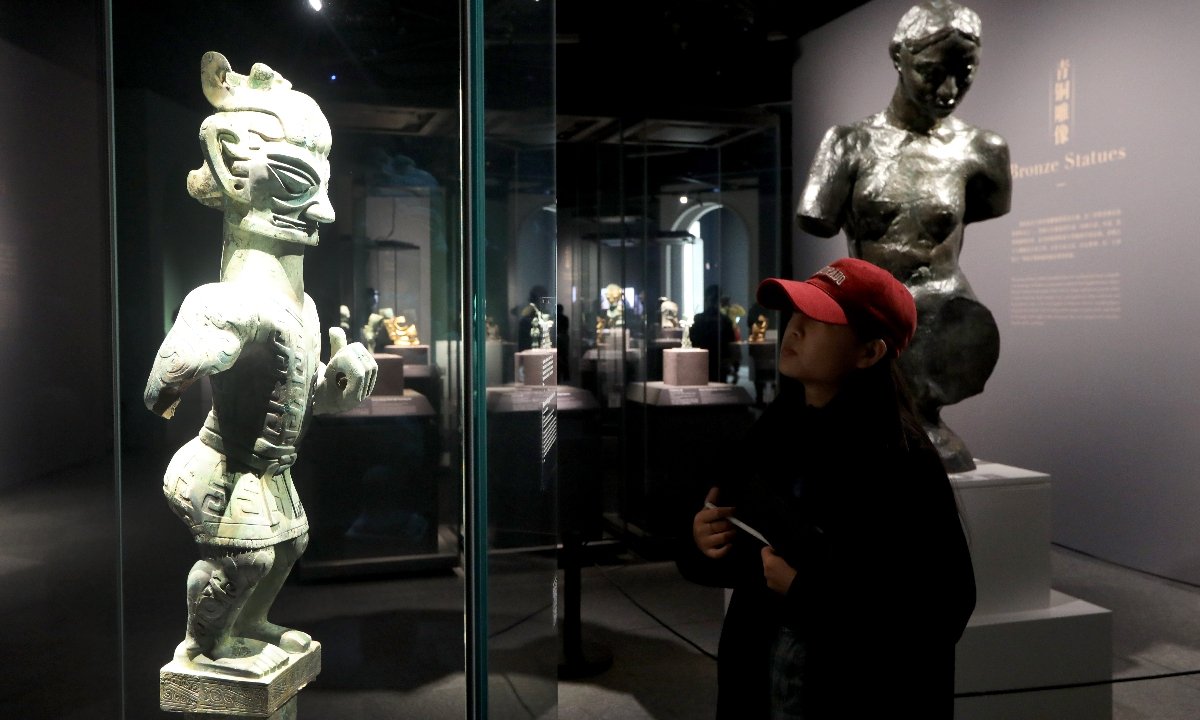In an extraordinary blend of ancient Chinese art and French sculpture, the Shanghai University Museum hosts a remarkable exhibition titled “Glory of Bronze Civilization: A Dialogue between Sanxingdui and Auguste Rodin across Space and Time.” This exhibition, which aligns with the ongoing fifth Shanghai Archaeology Forum, offers a unique juxtaposition of millennium-old Chinese bronzes from the renowned Sanxingdui Ruins and the iconic works of French art giant Auguste Rodin.
Set against the backdrop of the upcoming 60th anniversary of Sino-French diplomatic relations in 2024, this exhibition is more than an artistic endeavor; it’s a symbolic gesture of the deepening cultural ties between the two nations. It presents an unexpected harmony between artworks from diverse continents and eras, inviting visitors into a transcendent dialogue of civilizations.
The exhibition showcases 36 ancient Chinese cultural relics, predominantly from the 3,000-year-old Sanxingdui Ruins, alongside 21 modern artworks by Western artists, including master sculptor Rodin. Despite their different origins, both the Sanxingdui civilization and Rodin’s sculpture art share intriguing commonalities, as noted by Li Mingbin, the museum’s director. Central to this connection is their use of bronze as a primary medium and the depiction of humans and gods as key subjects, creating an internal logical basis for a cross-cultural dialogue.
Li Mingbin emphasizes the exhibition’s role in fostering mutual learning between Chinese and Western civilizations in art and archaeology. He believes that, deep down, humans share similar worldviews and values across time, regions, ethnicity, and culture. Thus, preserving and inheriting the diverse and colorful cultures of human society becomes a fundamental purpose and common mission for museums worldwide.
Among the must-see exhibits, the Bronze Standing Figure Wearing a Skirt from Sanxingdui, unearthed in 2022, stands out. This figure, with its unique physical attributes, represents a significant role in ancient sacrificial ceremonies. Another highlight is Rodin’s Torso of the Muse Whistler, a symbolic representation of US painter James Whistler’s stature in the art world, deviating from traditional realistic depictions.
The Rodin sculptures are exhibited courtesy of the Rodin Art Center (Rodin Museum China Branch), in collaboration with the Paris-based Rodin Museum. Wu Jing, the center’s director, expresses her admiration for the “invisible energy” generated by these diverse artworks and civilizations, emphasizing their universal cultural significance.
This exhibition, coinciding with the 60th anniversary of China-France diplomatic relations, is a precursor to various planned cultural exchanges between the two countries. Wu Jing, proud of the inclusion of Rodin’s works, hopes for more such events under the umbrella of China-France friendship and cultural learning.
Jointly sponsored by Shanghai University (SHU) and the Sichuan Provincial Cultural Heritage Administration, the exhibition is co-organized by multiple institutions including the Shanghai University Museum, Rodin Art Center, and various Sichuan cultural and archaeological institutes. This remarkable exhibition, which commenced on December 13, will be open to the public until February 1, 2024, offering a unique opportunity to witness a conversation between epochs and cultures, mediated through the timeless language of art.
READ MORE:
